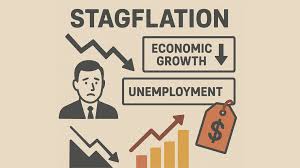Stagflation: Intensified In The United States

In May 2025, concerns over stagflation have intensified in the United States. Banks are now sitting on $482.4 billion in unrealized losses from securities investments, a 32.5% increase from the previous quarter, according to the Federal Deposit Insurance Corporation (FDIC).
- Stagflation is an economic phenomenon where an economy experiences three adverse conditions simultaneously:
- High inflation (rising prices)
- Stagnant or slow economic growth
- High unemployment
- The term was first used in the 1960s and became prominent during the 1970s oil crisis.
- Stagflation is particularly challenging because the usual economic tools to fight inflation or unemployment often worsen the other problem.
- Causes of Stagflation:
- Supply Shocks: Sudden spikes in the cost of essential resources (like oil) increase production costs, leading to both inflation and reduced output.
- Policy Errors: Poorly coordinated fiscal and monetary policies, such as excessive government spending or delayed interest rate hikes, can fuel inflation while failing to stimulate growth.
- Tariff Increases: Recent U.S. tariffs have raised input costs, potentially triggering stagflation by increasing prices and reducing demand.




